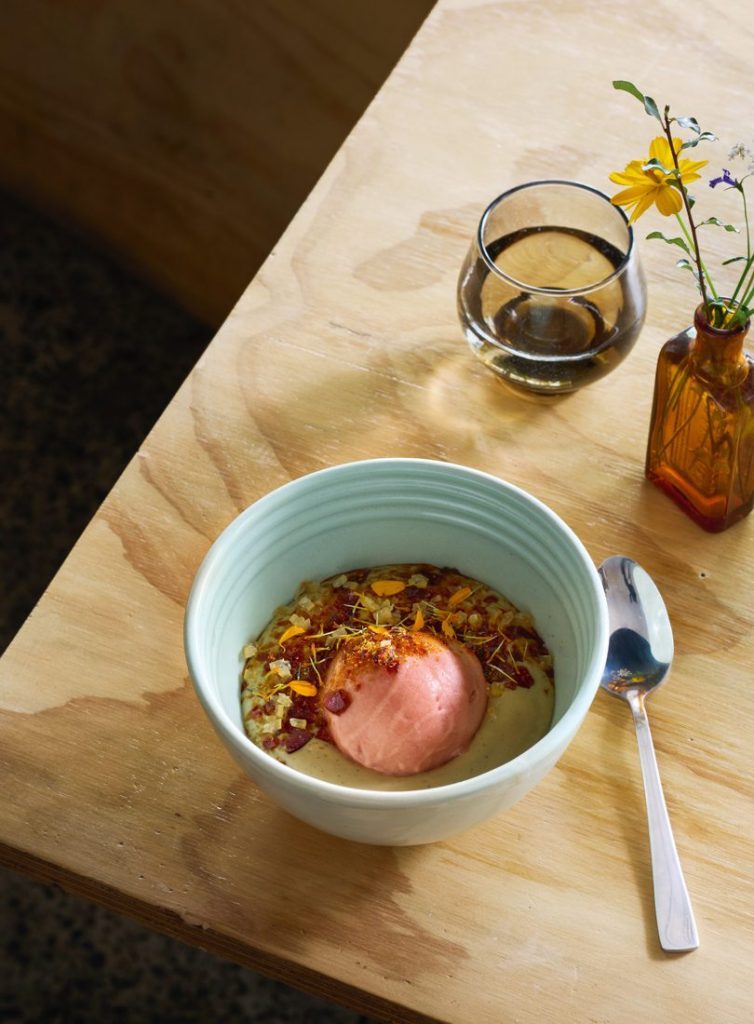MARIGOLD CUSTARD WITH RHUBARB SORBET, BURNT SUGAR & PRESERVED LEMON
Plabita Florence

Serves
4Preparation
15 mins plus 40 mins churning timeCook
40 minsIngredients
| 500ml milk | |
| 1 teaspoon vanilla paste | |
| 670g sugar | |
| 6g (approx two handfuls) Mexican marigold flowers (if it’s not flowering the leaves can be used instead, but the custard won't be as yellow) | |
| 6 egg yolks | |
| 3 tablespoons cornflour | |
| 600g rhubarb, roughly chopped | |
| juice of 2 lemons | |
| 1 tablespoon apple cider vinegar | |
| 1 tablespoon vodka | |
| 1 preserved lemon skin, flesh and pith removed, finely diced |
The Mexican marigold (Tagetes erecta) is a tall bush with small, vibrant yellow flowers. To tell if it’s the right kind of marigold, crush up a leaf or flower: if it’s the right one it’ll leave your hand smelling like a fragrant mix of floral papaya, mango and bubble gum. Other varieties of marigold will not work here, but you could use scented rose petals instead.
Instructions
| 1. | MARIGOLD CUSTARD |
| 2. | Put the milk, vanilla, 80g sugar, a pinch of salt and the marigolds in a blender. |
| 3. | Blend for 2 minutes then pass through a fine sieve into a pot. |
| 4. | Add the egg yolks and cornflour and whisk constantly over a low heat until the custard thickens up, approx 10 minutes. |
| 5. | This is easily made vegan by replacing the egg yolks with more cornflour (¾ cup cornflour, stirred into a smooth slurry with 1¼ cups of cold water) and using a substitute milk. |
| 6. | RHUBARB SORBET |
| 7. | Combine the rhubarb with 450g sugar, 300ml water, the lemon juice and apple cider vinegar, and cook until falling apart. |
| 8. | Allow to cool a bit, then blend. |
| 9. | Pass the mixture through a sieve pressing with a spatula to remove the rhubarb fibres. You should be left with a satisfyingly smooth curd. |
| 10. | Transfer to an ice-cream churner along with 1 tablespoon vodka (to stop the sorbet from freezing too hard). |
| 11. | Churn until fluffy and scoopable, then put it in an airtight container in the freezer. |
| 12. | BURNT SUGAR PRALINE |
| 13. | Line a tray with baking paper and set aside. |
| 14. | Put 140g sugar and 120ml water in a small pot. |
| 15. | Bring up to a medium heat and hold it there – you want to see enthusiastic bubbling, but if it’s threatening to bubble over it is too hot. |
| 16. | Do not stir or move the mix around at all as the sugar crystals at this stage are temperamental and to achieve a perfectly crunchy praline we need to just let them do their thing. |
| 17. | Keep an eye on it, because once the colour starts to change it’ll happen quickly. |
| 18. | When you see the edge start to turn caramel brown, swirl the pot to combine, leave for a moment and repeat. |
| 19. | Once the whole mix is brown, this is when you would normally take the praline off the heat, but we’re burning it on purpose for this dessert, so leave it a minute longer. |
| 20. | Just as the colour starts to deepen and you detect a whisper of smoke coming off it, we’ve arrived at the gates of burnt. |
| 21. | Immediately pour it out onto the tray and carefully tilt the tray to evenly coat the surface. |
| 22. | Allow to cool completely, then smash up with the back of a wooden spoon, or in a food processor. You want it to be almost a powder; this is quite bitter so you don’t want huge bits. |
| 23. | Transfer into an airtight jar (as soon as moisture finds its way into your praline it’ll start clumping up; I find keeping it in the fridge helps avoid this, too). |
| 24. | TO SERVE |
| 25. | Put two serving spoonfuls of custard into each bowl (if the custard has developed a skin, give it a quick whisk and pass through a sieve before serving). |
| 26. | Make a well in the centre of the custard and fill it with a scoop of sorbet. |
| 27. | Sprinkle with a layer of praline and a scattering of preserved lemon. |
| 28. | I had a few marigolds left, so I tossed them in, too. |
Recipes & food styling Plabita Florence / Photography Tony Nyberg

Leave a Reply